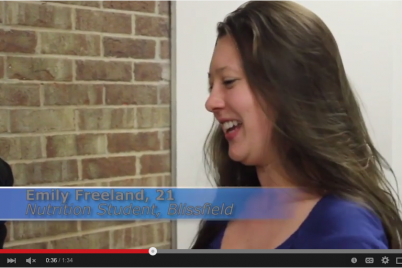
ILLUSTRATION by Natalie Allinger | The Washtenaw Voice
By Jenee Gregor
Deputy Editor
When scrolling down a Facebook feed, the accuracy of a story isn’t the first thought. Information is glanced upon and reader’s attention spans are shortening. In 2000, a Canadian research study concluded that they had an attention span of about 12 seconds. Now, it is proposed that humans have about an eight second attention span.
Is eight seconds enough to really know anything you read for certain?
“People glance at headlines and that’s the way that they read. Info-snacking is the jargon term,” said David Waskin, WCC journalism program adviser and instructor.
Info-snacking is a term that explains what people are doing with the flooded news feeds, tweets, emails and so on. Just grabbing bits and pieces of headlines, memes and snippets of information and then operating from there.
As the clickbait continues to roll passed eyes of the scroller, what makes it into the memory banks? Things like “pizzagate,” where a story was crafted about a pizza place in Washington D.C. linked to a pedophiliac sex slave trade.
The news had traveled so far and well believed that a man went into Comet Pizza, the restaurant under fire for this rumour and fired a rifle, ready to free these child slaves as reported by a NPR article in December.
“I use Snopes to fact-check” said Luis Villa, physical therapy assistant student at WCC.
“The people that seemed to be really for this story or strongly believe this tended to stray away from mainstream news, and reached to alternative sources,” said Waskin.
There are theories and rumors that have floated about and in a charged time, filled with political rhetoric from e-mails to the scandalous alt-right.
“The real culprit is confirmation bias. This phenomenon that we will look for or readily accept information that confirms beliefs that we already hold,” said Waskin.
Outside of this, there are some guidelines that are important to deciphering truth behind the sources before the article is even clicked on. Some things are common sense, but just because it’s a posted article doesn’t mean that it is based in truth.
Looking for a logo or a trusted insignia from a long-running journalistic source, looking for spelling errors in the title and description. And the organization itself, said Waskin.
When scrolling and in the corner of the page there is a website address, are places to look for credibility, using websites that are, .gov, .edu or .org are more reliable said Lindsay Fischer, WCC journalism instructor.
“Go back to the source,” Fischer said. Checking the facts for each person, to make sure the truth is presented.
“A government website, and organization potentially might be biased but more reliable or a trusted news organization is more trustworthy, not just looking at a headline and moving on from there, but clicking on it and going to the website and finding out what the source is.”
Not just trusting that reporting has covered all the bases but to do their own reporting and research. Read into the facts and look markers of truth, not just snacking on information, but actually looking into the resources.


